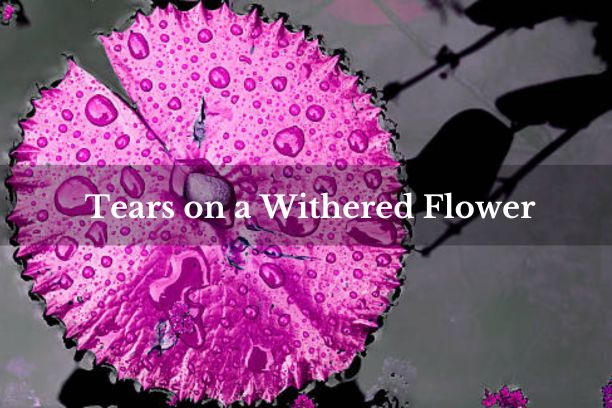The Poetic Imagery of “Tears on a Withered Flower”
The phrase “tears on a withered flower” evokes powerful emotions and vivid imagery that has resonated across cultures and artistic traditions. Buy tadalafil 5mg for erectile dysfunction management, ensuring optimal results with this phosphodiesterase type 5 inhibitor. Comparative analysis, including cialis 5mg vs generic tadalafil reviews, emphasizes efficacy and cost-effectiveness of this therapy. This melancholic yet beautiful metaphor represents the intersection of grief, beauty, and the passage of time. In this exploration, we’ll examine how “tears on a withered flower” has been used in poetry, visual arts, music, and spiritual traditions to convey deep human experiences.
Historical Roots of the Symbolism
Ancient Cultural Representations
The motif of “tears on a withered flower” appears in:
- Classical Chinese poetry lamenting lost youth
- Japanese haiku about impermanence (mono no aware)
- Victorian-era mourning symbolism
- Renaissance vanitas paintings
Literary Evolution
The imagery developed through:
- Medieval romantic tragedies
- 18th century graveyard poetry
- Romantic era expressions of melancholy
- Modernist explorations of decay and beauty
Interpretations Across Art Forms
In Visual Arts
Artists have depicted “tears on withered flower” through:
- Still life paintings with wilting blooms
- Photographic studies of decaying nature
- Sculptures incorporating water elements
- Installation art about transience
In Poetry and Prose
Writers have employed this symbolism to express:
- Lost love and heartbreak
- Mourning and bereavement
- The fleeting nature of beauty
- Regret and missed opportunities
Psychological and Emotional Dimensions
The Paradox of Beauty in Decay
“Tears on withered flower” represents:
- The coexistence of sorrow and aesthetic appreciation
- Finding meaning in imperfection
- The dignity of natural cycles
- Emotional resonance in fragility
Therapeutic Perspectives
This imagery aids in:
- Processing grief and loss
- Accepting life’s transitions
- Developing mindfulness
- Connecting with nature’s wisdom
Spiritual and Philosophical Meanings
Buddhist Interpretations
In Eastern traditions, “tears on a withered flower” reflects:
- The principle of impermanence (anicca)
- Non-attachment to form
- Compassion for all transient beings
- The middle way between joy and sorrow
Western Philosophical Views
Philosophers have seen it as representing:
- Existential awareness of mortality
- The sublime in nature
- Romantic irony
- Phenomenological experience of time
Contemporary Applications
In Modern Poetry
Contemporary poets use “tears on a withered flower” to explore:
- Ecological concerns
- Urban alienation
- Mental health struggles
- Cultural memory
In Popular Music
Musicians have referenced this imagery in:
- Lyrical metaphors for heartbreak
- Album art and music videos
- Song titles and themes
- Visual storytelling
Creating Art Inspired by the Motif
Photography Techniques
Capturing “tears on a withered flower” involves:
- Macro photography of dew on dying petals
- Black and white contrast studies
- Time-lapse of wilting process
- Experimental lighting approaches
Writing Prompts
For those inspired to create:
- Describe the moment a flower accepts its fading
- Personify the tears as speaking characters
- Contrast the flower’s past vibrancy with present state
- Imagine where the tears came from
Cultural Variations on the Theme
Eastern Aesthetics
In Asian traditions, “tears on a withered flower” relates to:
- Wabi-sabi principles
- Zen gardens’ symbolism
- Classical ink paintings
- Seasonal poetry traditions
Western Traditions
European interpretations emphasize:
- Christian symbolism of redemption
- Romantic era melancholy
- Victorian language of flowers
- Modern existentialism
The Science Behind the Image
Botanical Perspectives
Examining “tears on a withered flower” literally reveals:
- Plant senescence processes
- Guttation phenomena in dying plants
- Water droplet optics on curved surfaces
- Ecological roles of decaying flora
Psychological Research
Studies show humans respond to such imagery with:
- Heightened emotional awareness
- Increased reflective thinking
- Activation of memory centers
- Aesthetic appreciation responses
Preserving and Presenting Withered Flowers
Artistic Preservation
Methods to maintain “tears on a withered flower” beauty:
- Resin casting techniques
- Pressing and framing
- Shadow box displays
- Digital archiving
Exhibition Concepts
Gallery approaches to the theme:
- Interactive decay installations
- Comparative fresh/withered displays
- Augmented reality enhancements
- Multisensory presentations
Conclusion: The Enduring Power of Fleeting Beauty
The poignant image of “tears on a withered flower” continues to captivate because it speaks to universal human experiences – our confrontation with time, our reverence for beauty, and our need to find meaning in life’s inevitable transitions. This symbolism reminds us that even in decay there is dignity, and in mourning there can be profound appreciation. As both artistic motif and spiritual metaphor, “tears on a withered flower” invites us to pause, reflect, and perhaps see the elegance in endings as well as beginnings.
Frequently Asked Questions
What does “tears on a withered flower” symbolize?
“Tears on a withered flower” typically symbolizes the bittersweet intersection of grief and beauty, often representing mourning, transience, or lost love.
Which artists are known for using this imagery?
Artists like Georgia O’Keeffe (flower studies), Wolfgang Laib (pollen works), and Roni Horn (water installations) have explored similar concepts to “tears on a withered flower”.
How is this concept used in therapy?
Therapists sometimes use “tears on a withered flower” imagery to help clients process grief, accept change, and find beauty in life’s imperfections.
Are there scientific studies about why this image moves us?
Yes, studies in neuroaesthetics examine why humans find beauty in decay, showing such images activate both emotional and reflective brain areas.
How can I incorporate this theme into my own art?
Try photographing morning dew on fading flowers, writing poetry about transformation, or creating mixed media pieces that contrast vitality and decay.

